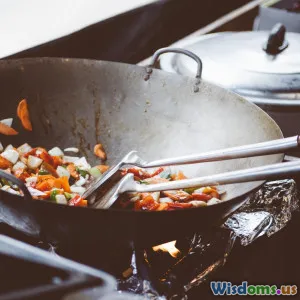
How Steaming Your Food Can Preserve More Vitamins Than Other Methods
8 min read Discover how steaming food preserves more vitamins compared to other cooking methods and enhances nutrition and flavor. (0 Reviews)
How Steaming Your Food Can Preserve More Vitamins Than Other Methods
Introduction
Imagine boosting the nutritional value of your meals simply by changing how you cook. Many of us believe that cooking inevitably robs vegetables and other foods of their precious vitamins and minerals. But the truth isn't as bleak as it sounds—how you cook plays a critical role in how much nutrition remains on your plate. Among various methods, steaming stands out as a remarkable technique to retain vitamins more effectively than boiling, frying, or baking.
This article dives deep into why steaming is superior for preserving vitamins, details scientific findings, compares different cooking techniques, and equips you with practical cooking tips that protect your food's nutritional richness.
Why Vitamins Matter and How Cooking Affects Them
Vitamins are organic compounds essential for vital bodily functions, including immune support, bone health, energy production, and skin maintenance. Water-soluble vitamins like Vitamin C and the B-complex family are particularly sensitive to heat and water exposure, often degrading during cooking.
For instance, Vitamin C is renowned for its antioxidant properties but degrades rapidly when exposed to water and heat. Fat-soluble vitamins (A, D, E, K), while more stable, can still be affected by heat and prolonged cooking times.
Therefore, the goal when cooking vegetables or nutrient-rich foods is to minimize vitamin loss while ensuring the food is safe and palatable.
The Science Behind Steaming and Vitamin Preservation
What is Steaming?
Steaming is a cooking method where food is exposed to steam vapor from boiling water, cooking it gently without direct contact with water. Temperatures during steaming typically range from 100°C (212°F) upwards, which cooks the food evenly and quickly.
How Steaming Protects Vitamins
- Minimal Contact with Water: Since steaming cooks food with steam rather than immersion in water, water-soluble vitamins like vitamin C and B vitamins leach out much less.
- Shorter Cooking Times: Steaming heats food efficiently, often requiring less cooking time, reducing heat exposure that can break down vitamins.
- Reduced Oxidation: Steaming limits oxygen exposure compared to methods like sautéing or deep frying, protecting antioxidants.
Comparative Studies
-
A study published in the Journal of Food Science and Technology (2017) compared vitamin C retention in broccoli processed by boiling, microwaving, and steaming. Steamed broccoli retained up to 89% of its vitamin C, boiling retained only 66%.
-
Similarly, a 2012 LWT - Food Science and Technology study noted steaming retained 72%–90% of carotenoids in carrots, compared to 55% retention after boiling.
-
Harvard Health highlights that steaming helps keep mineral content intact better than boiling, which can leach minerals into cooking water.
How Other Cooking Methods Impact Vitamins
Boiling
Boiling submerges food in hot water for various lengths of time. Because water-soluble vitamins dissolve easily, they leach into the cooking water, which is usually discarded. This can cause significant nutrient loss — sometimes over 40% for Vitamin C and B-complex vitamins.
Example: Boiling spinach causes rapid vitamin loss not only because of high temperature but also because its vitamins dissolve into the water.
Frying
Frying exposes food to very high temperatures and oil, which can degrade heat-sensitive and fat-soluble vitamins. Moreover, prolonged frying can produce harmful compounds that negate nutritional benefits.
Example: Vitamin C is almost completely destroyed when frying certain vegetables because of the intense heat.
Baking and Roasting
These dry-heat methods use hot air to cook food inside an oven. Though better than boiling for preserving minerals, vitamins, especially water-soluble and heat-sensitive ones, still degrade due to prolonged exposure to heat.
Microwaving
Microwaving, like steaming, is a quick cooking method that uses electromagnetic waves to heat water molecules in food internally. This can preserve vitamins better than boiling but may cause uneven heating depending on the appliance.
Real-World Insights and Practical Tips
Keep Steaming Simple
- Use minimal water to generate steam—not a large volume where the food will sit in water.
- Avoid overcooking: check tenderness frequently since over-steamed food still loses vitamins.
Examples of Nutrient-Rich Foods That Benefit from Steaming
- Broccoli: Steaming enhances bioavailability of glucosinolates, compounds beneficial for cancer prevention, while preserving vitamin C.
- Spinach: Preserves folate and vitamin C.
- Carrots: Retains beta-carotene and antioxidants when steamed briefly.
- Fish and Chicken: Steaming preserves moisture and sensitive vitamins like B6 and B12.
Expert Perspectives
According to Dr. Cheryl Myers, a nutrition scientist with the University of Washington, "Steaming is one of the best ways to cook vegetables while minimizing nutrient loss. It ensures we get the fiber texture with locked-in vitamins, making meals both tasty and healthful."
Incorporate Steaming Into Your Routine
Electric steamers, bamboo steamers, or even stove-top steaming baskets are affordable tools that can enhance your health with minimal adjustments to cooking habits.
Conclusion
Cooking doesn't have to come at the cost of nutrition. Steaming represents an uncomplicated yet scientifically supported method to maximize vitamin preservation in your meals. By replacing boiling or deep frying with steaming, you retain more of the water-soluble and heat-sensitive vitamins essential for well-being.
Whether you’re steaming broccoli, carrots, or delicate fish, this technique safeguards the nutritional integrity and natural flavors of foods. Embracing steaming is an easy yet impactful way to nourish your body deeply and enjoy vibrant, healthful food every day.
Next time you prepare dinner, consider a simple steamer basket—it might just transform your health one vitamin-rich bite at a time.
Rate the Post
User Reviews
Other posts in Nutrition
Popular Posts
















